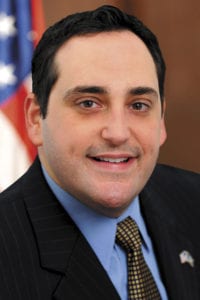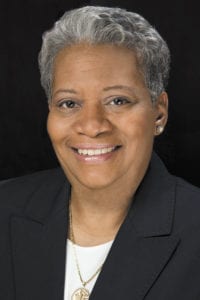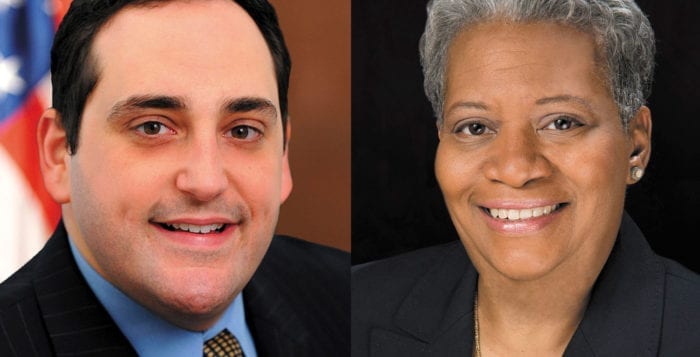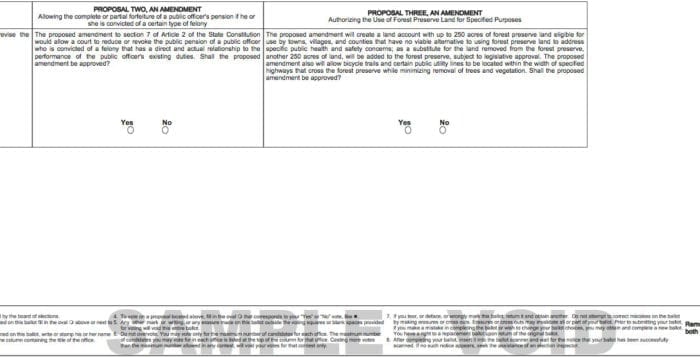Two of Huntington’s elected officials are running against one another to snag the open seat of town supervisor, as 24-year incumbent Frank Petrone (D) announced he was not seeking re-election. The candidates met recently at TBR News Media offices in Setauket.
Councilwoman Tracey Edwards (D) was elected to the town board in 2014, after serving 10 years on the Elwood board of education. She worked for 37 years at Verizon, climbing the ladder to regional president of network operations.
Edwards said she is running to see through some of the changes and programs she’s started.

State Assemblyman Chad Lupinacci (R) was elected in 2012, and serves as the ranking Republican member on the Assembly Higher Education Committee. Previously, he was a trustee on the South Huntington school board for nine years. He now wants to bring his experience to benefit the town.
Both Edwards and Lupinacci agree that public safety is one of the biggest issues the next supervisor will face.
Lupinacci stressed that the next supervisor will need to ensure the town cooperates with county and state officials to pool resources to keep the pressure on gangs and the heroin/opiate addiction issue. He proposes monthly meetings with area school superintendents to help determine how the town can help school districts, and more after-school and summer programs like the Tri-CYA to keep youths off the streets.
Edwards said the effort to cooperate for the sake of improving public safety is already there.
“The things we are doing right is that we have partnered with the [county] police department, we have partnered with the state liquor authority, and we have been a participant going with them on raids,” she said. “We are intimately involved in that to address the criminal nature of the code aspect of it, so that if there is something, we can shut it down.”
The Democratic candidate pointed to the recent shutdown of two Huntington Station bars with ties to gang activity, but said the town needs to be even more proactive. Her five-point plan to improve public safety includes getting more state resources to create a stronger public safety office within the town, creation of a heroin/opiate task force and adding more lighting to improve visibility in areas that are hot zones for crime.
Governmental reforms are needed in Huntington, according to both candidates, starting with a three-term limit, or 12 years, in office.
Edwards also wants to create additional meetings where town department heads meet directly with citizens to hear and answer their concerns, make town hall’s entrance more customer service-oriented, and distributing government forms to local libraries to make them easier to obtain.

Lupinacci suggests increasing the number of town board meetings and taking them on the road, hosting them in schools to allow more people to attend. Edwards disagreed.
“Taking town hall on the road would be confusing to people,” she said. “I think people will be showing up at town hall and have no idea where the town board is meeting.”
Lupinacci said a list of town board meeting dates and locations could be printed on the annual recycling calendar mailing.
“We also need to increase the amount of residents’ speaking time,” he said. “Right now, it’s clipped at three minutes. We want to increase it to five minutes to give people more time to speak on the issues.”
His other proposals include creating an online checkbook on the town’s website where taxpayers can see where their money is being spent, create an online freedom of information to request town documents, and providing a greater breakdown of the town budgeting process over a series of meetings to allow for more input.
Lupinacci also stressed the lack of available parking in Huntington village is an ongoing issue that needs to be addressed — he says a parking garage is overdue.
Edwards insists a parking garage for the village is currently in the works, but said each of the town’s hamlets have different issues of importance.




 Lisa Scott is the president of the League of Women Voters of Suffolk County, a nonprofit, nonpartisan organization that encourages the informed and active participation of citizens in government and influences public policy through education and advocacy. For more information, visit www.lwv-suffolkcounty.org, email
Lisa Scott is the president of the League of Women Voters of Suffolk County, a nonprofit, nonpartisan organization that encourages the informed and active participation of citizens in government and influences public policy through education and advocacy. For more information, visit www.lwv-suffolkcounty.org, email 


